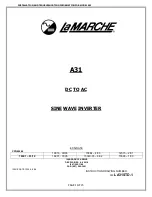
Absorption and float LEDs
flash synchronously
(simultaneously).
The battery temperature as measured has an extremely unlikely value. The sensor is
probably defective or has been incorrectly connected. The device will remain in normal
operation.
If the "inverter on" LED flashes in phase opposition, this a VE.Bus error
code (see further on).
7.3. VE.Bus LED indications
Equipment included in a VE.Bus system (a parallel or 3-phase arrangement) can provide so-called VE.Bus LED indications.
These LED indications can be subdivided into two groups: OK codes and error codes.
7.3.1. VE.Bus OK codes
If the internal status of a device is in order but the device cannot yet be started because one or more other devices in the system
indicate an error status, the devices that are in order will indicate an OK code. This facilitates error tracing in a VE.Bus system,
since devices not requiring attention are easily identified as such.
OK codes will only be displayed if a device is not in inverter or charging operation!
• A flashing ‘bulk’ LED indicates that the device can perform inverter operation.
• A flashing ‘float’ LED indicates that the device can perform charging operation.
In principle, all other LEDs must be off. If this is not the case, the code is not an OK code. However, the
following exceptions apply:
• The special LED indications above can occur together with the OK codes.
• The ‘low battery’ LED can function together with the OK code that indicates that the device can charge.
7.3.2. VE.Bus error codes
A VE.Bus system can display various error codes. These codes are displayed with the “inverter on”, “bulk”, “absorption” and
“float” LEDs.
To interpret a VE.Bus error code correctly, the following procedure should be followed:
1. The device should be in error (no AC output).
2. Is the ‘inverter on’ LED flashing? If not, then there is no VE.Bus error code.
3. If one or more of the LEDs ‘bulk’, ‘absorption’ or ‘float’ flashes, then this flash must be in phase opposition to the ‘inverter on’
LED, i.e. the flashing LEDs are off if the ‘inverter on’ LED is on, and vice versa. If this is not the case, then there is no VE.Bus
error code.
4. Check the ‘bulk’ LED, and determine which of the three tables below should be used.
5. Select the correct column and row (depending on the ‘absorption’ and ‘float’ LEDs), and determine the error code. 6.
Determine the meaning of the code in the tables below.
6. Determine the meaning of the code in the tables below.
MultiPlus-II 48V 3kVA 120V
Page 23
Error Indications













































